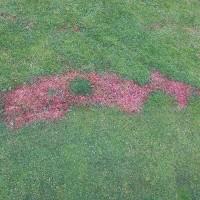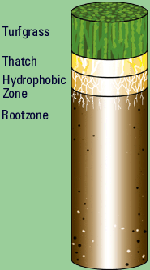Dry Patch
Although only associated with fine turf, ornamental lawns and sports turf ,research has shown the initial cause of dry patch is the build -up of naturally produced waxes around the sand/soil particles within the root-zone. When these coated sand/soil particles dry out they become hydrophobic (water-repellent) and the root-zone is unable to hold water. Dry patch usually appears during periods of dry weather as small isolated patches of thin, stressed water repellent turf. The symptoms can affect all turf-grass species but initially are more apparent on the shallower rooted species i.e. annual meadow grass where total die back of the plant can occur very quickly. Other causes of dry patch that should not be discounted are competition from adjacent trees and large shrubs that may be situated around your lawn.
Beneath the surface in these affected areas the soil is extremely dry and will not easily re-wet. Research has shown that the build up of waxes around the sand/soil particles that cause dry patch are concentrated at the soil thatch interface and this area is referred to as the hydrophobic zone.

Remedy
Ensure thatch is less than ½”. If it is more then it must be reduced. However, if you scarify you may need to over seed afterwards. This could be a problem on soil that is water repellent so if you do need to scarify, New Horizon Lawn-care would recommend a deep scarify in the spring as the soil should be wet from the winter months.

Next the lawn will definitely need aerating to allow water to penetrate. We would hollow tine to open the turf up and relieve compaction. It should be noted that hollow tining in particular will increase drying of the lawn surface so be prepared to water if the weather is dry.
The penultimate step is to apply what is known as a ‘Wetting Agent’. Though this does not cure the water repellent nature of the soil it will enable it to stay wet if water is applied. You will need to apply wetting agent 3 to 4 times throughout the summer to maintain water penetration.
